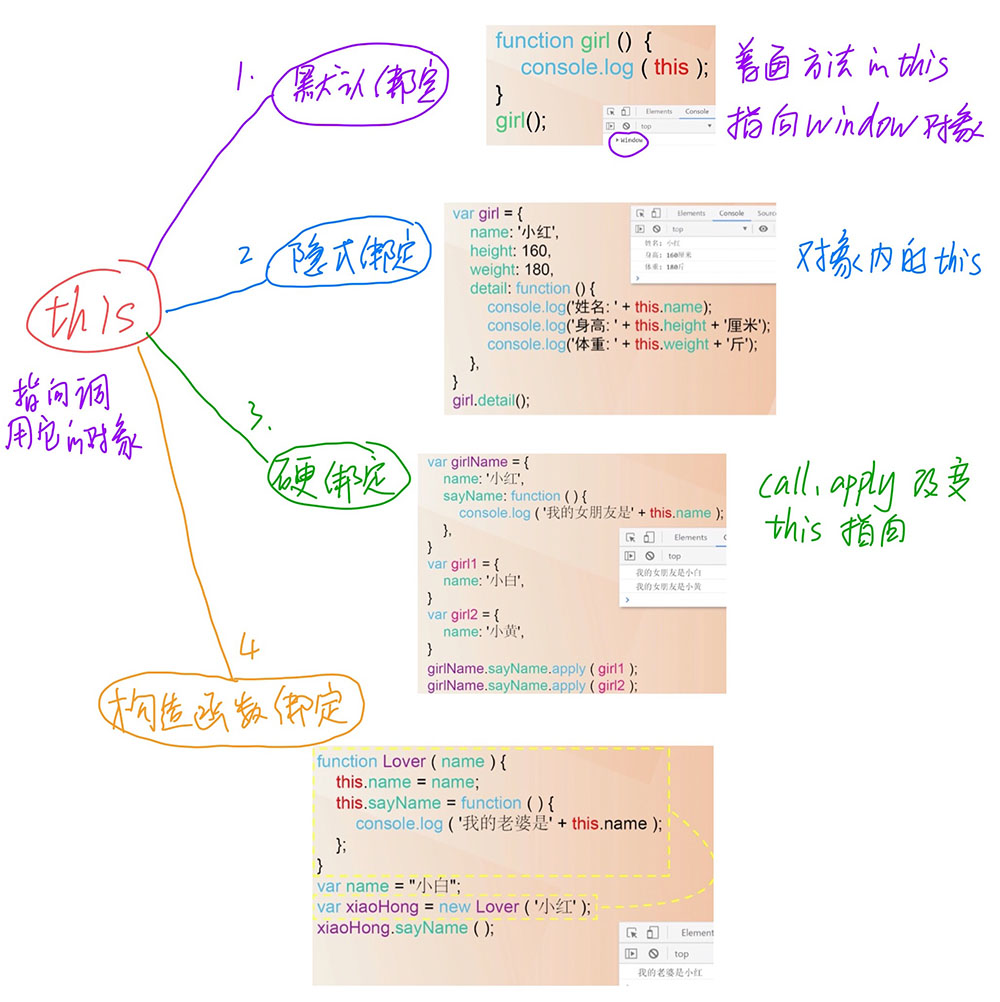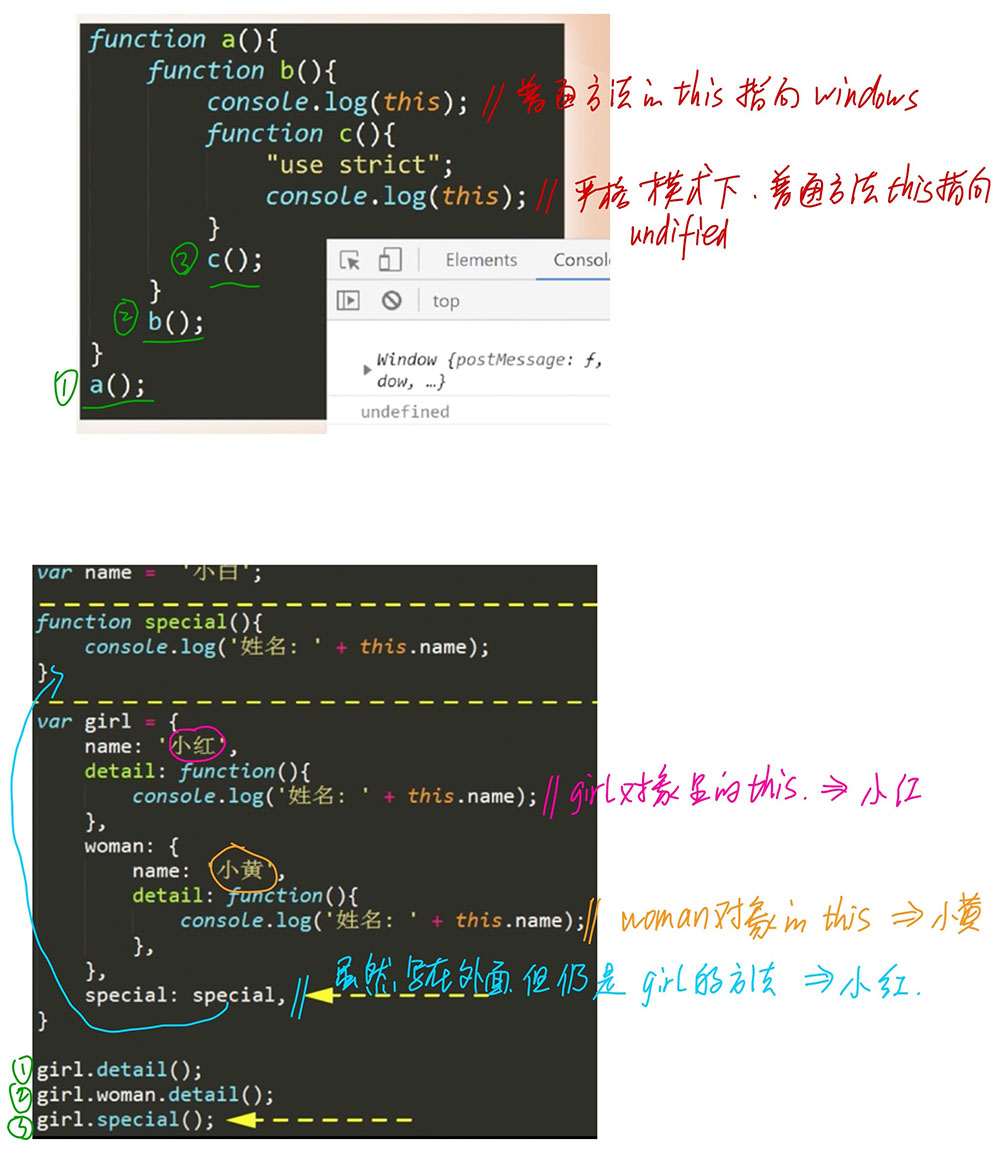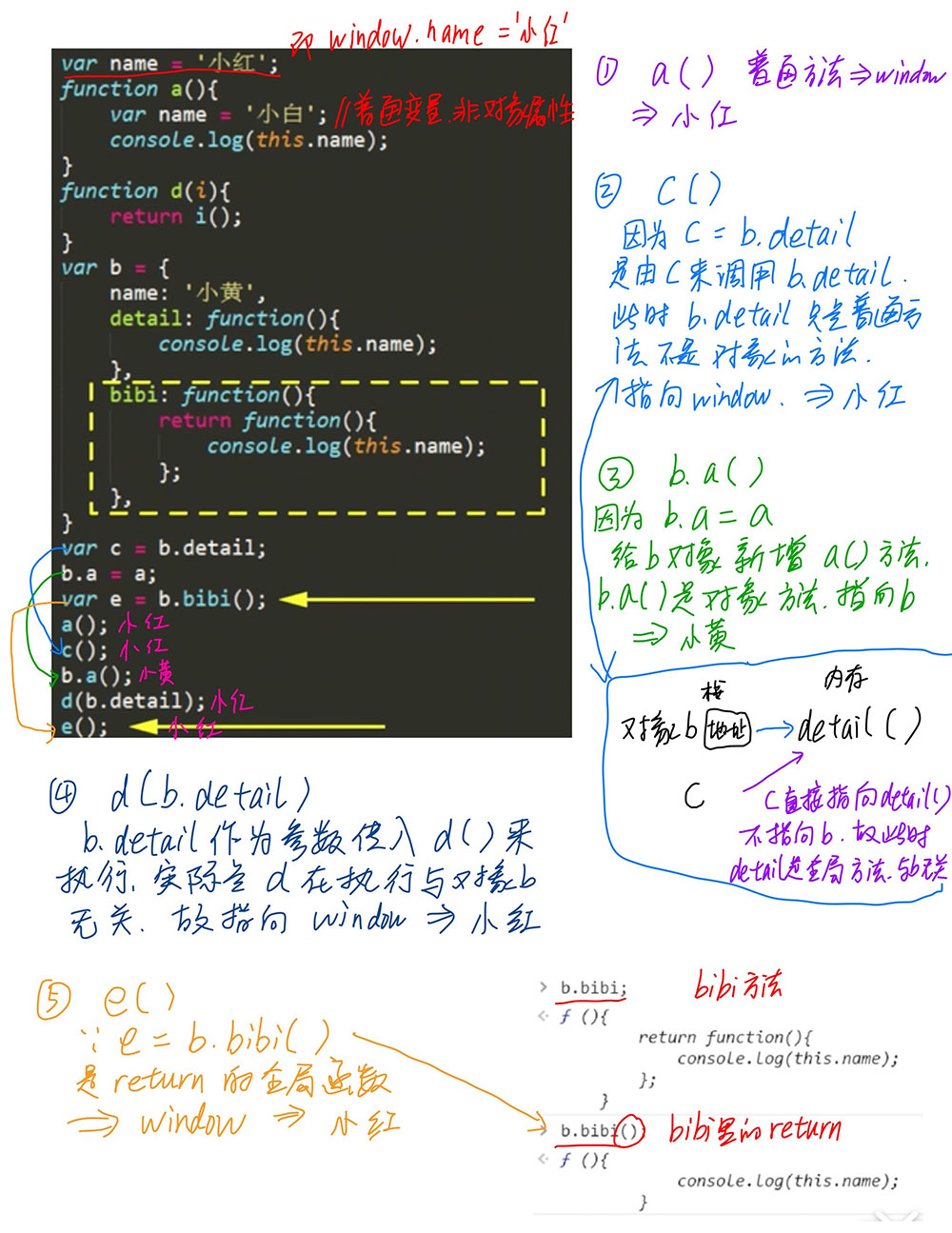面向对象语言中 this 表示当前对象的一个引用, 它会随着执行环境的改变而改变。
this绑定的四种情况:
- new 绑定。
new实例化- 显示绑定。
call、apply、bind手动更改指向- 隐式绑定。由上下文对象调用,如
obj.fn(),this指向obj- 默认绑定。默认绑定全局对象(没有被上下文对象调用,也是全局对象),在严格模式下会绑定到
undefined。优先级new绑定最高,最后到默认绑定。
在obj function中,this 表示该方法所属的对象
function test() {
console.log(this.x);
}
var obj = {};
obj.x = 1;
obj.m = test;
obj.m(); // 1 variable 定义使用,this 表示全局对象
window 就是该全局对象为 [object Window]
<script>
var x = this;
document.getElementById("demo").innerHTML = x;
</script>在普通函数中,this 表示全局对象。
function myFunction() {
return this;
}在函数中,在严格模式下,this 是未定义的(undefined)。
"use strict";
function myFunction() {
return this;
}
function sayMyName(){
var name = "JavaScript"
console.log(this.name);//undefined
console.log(this.name);//Window
}
sayMyName();
window.sayMyName();
//箭头函数
var name = "windows";
var arrowFun=()=>{
console.log(this.name);
}
arrowFun(); // 结果:windows
// 原因:箭头函数this指向取决于它定义时的父级作用域思考下面的函数作用域
var x = function () {
console.log(a);
};
function y(f) {
var a = 2;
f();
}
y(x)
// ReferenceError: a is not defined
var a = 1;
var x = function () {
console.log(a);
};
function f() {
var a = 2;
x();
}
f() // 1函数x是在函数f的外部声明的,所以它的作用域绑定外层,内部变量a不会到函数f体内取值,所以输出1,而不是2。
总之,函数执行时所在的作用域,是定义时的作用域,而不是调用时所在的作用域
function foo() {
var x = 1;
function bar() {
console.log(x);
}
return bar;
}
var x = 2;
var f = foo();
f() // 1函数体内部声明的函数,作用域绑定函数体内部。
构造函数中,this指向constructor
var name = "windows";
function Person() {
this.name = "constructor";
this.fun1 = function () {
console.log(this.name); // 结果:constructor
};
this.fun2 = () =>{
console.log(this.name); // 结果:constructor
};
}
var p = new Person();
p.fun1(); // 结果:constructor
p.fun2(); // 结果:constructor
// 构造函数里的普通方法this指向构造函数new后的实例
// 箭头函数的this是父级作用域,父级是Person,Person是函数有自己的作用域且内部this指向自己
// 所以箭头函数的this就是指向person的prototype函数中定义的this (箭头/一般函数)
var name = "windows";
function Person() {
this.name = "constructor";
this.fun1 = function () {
console.log(this.name); // 结果:constructor
};
this.fun2 = () =>{
console.log(this.name); // 结果:constructor
};
}
Person.prototype.fun3 = function() {
console.log(this.name);
};
Person.prototype.fun4 = () => {
console.log(this.name);
}
var p = new Person();
p.fun3(); // 结果:constructor
p.fun4(); // 结果:windows
// 原因:fun3()挂在到原型上的普通方法的this指向构造函数new的实例
// 原因:fun4()挂在到原型上的箭头函数this取决于上下文的作用域,
// fun4()是在全局下挂载到Person的原型上的,所以this指向windowthis直向上级对象(一层对象)
var book = {
name: "JavaScript",
getBookName: function(){
return this.name;
}
}
console.log(book.getBookName());
// this指的是book 所以: JavaScript
//但是对于箭头函数
var name = "windows";
var obj = {
name: "objFun",
arrawFun: () => {
console.log(this.name); // 结果:windows
}
}
obj.arrawFun(); // 结果:windows
// 原因:箭头函数的this取决于父级作用域,父级是对象没有自己独立的作用域而是位于全局,所以向上延申,找到了window在事件中,this 表示接收事件的元素。
<button onclick="this.style.display='none'">
点我后我就消失了
</button>显示函数绑定,类似 call() 和 apply() 方法可以将 this 引用到任何对象。
var person1 = {
fullName: function() {
return this.firstName + " " + this.lastName;
}
}
var person2 = {
firstName:"John",
lastName: "Doe",
}
person1.fullName.call(person2); // 返回 "John Doe"apply()是函数的一个方法,作用是改变函数的调用对象。它的第一个参数就表示改变后的调用这个函数的对象。因此,这时this指的就是这第一个参数。
var x = 0;
function test() {
console.log(this.x);
}
var obj = {};
obj.x = 1;
obj.m = test;
obj.m.apply() // 0apply()的参数为空时,默认调用全局对象。因此,这时的运行结果为0,证明this指的是全局对象。
如果把最后一行代码修改为
obj.m.apply(obj); //1改变 this 指向- this apply bind
this 有他本身的指向性
不管你本身指向哪里, 我让你指向谁, 你就指向谁
- 三个方法
1. call() 2. apply() 3. bind()
- 三个方法
- call()
- 使用方法, 就直接连接再函数名后面使用
- 语法:
-> obj.fn.call()- 参数:
-> 第二个参数开始, 依次给函数传递参数- 特点:
- 作用:
var n = 123; var obj = { n: 456 , "f":functoin(){}}; function a() { console.log(this.n); } //重要的结论: a()=a.call(window) 如果是有参数的a("Hello world")=a.call(window,"Hello world")
a.call() // 123
a.call(null) // 123
a.call(undefined) // 123
a.call(window) // 123
a.call(obj) // 456
> 当被对象调用的时候,指向就是对象了哦
> obj.f()--> obj.f.call(obj)
> person.hello("world") --> person.hello.call(person, "world")
对于匿名函数
```js
(function(name) { })("aa");
//等价于
(function(name) { }).call(window, "aa");//调用原生
var obj = {};
obj.hasOwnProperty('toString') // false
// 覆盖掉继承的 hasOwnProperty 方法
obj.hasOwnProperty = function () {
return true;
};
obj.hasOwnProperty('toString') // true
Object.prototype.hasOwnProperty.call(obj, 'toString') // falsehasOwnProperty是obj对象继承的方法,如果这个方法一旦被覆盖,就不会得到正确结果。call方法可以解决这个问题,它将hasOwnProperty方法的原始定义放到obj对象上执行,这样无论obj上有没有同名方法,都不会影响结果。
- apply()
- 使用方法, 就直接连接再函数名后面使用
- 语法:
-> obj.fn.apply()- 参数:
-> 第二个参数: 是一个数组或者伪数组都行, 里面的每一项依次给函数传递参数- 特点:
- 作用: 可以以数组的形式给某些功能函数传参
//跟for each的差别, 会有跳过
var a = ['a', , 'b'];
function print(i) {
console.log(i);
}
a.forEach(print)
// a
// b
Array.apply(null, a).forEach(print)
// a
// undefined
// b- bind()
- 使用方法, 就直接连接再函数名后面使用
- 语法:
-> obj.fn.apply()- 参数:
-> 从第二个参数开始, 依次给函数传递参数- 特点:
-> 会返回一个新的函数, 一个已经被改变好 this 指向的函数- 作用:
var counter = {
count: 0,
inc: function () {
this.count++;//这里的this是windows
}
};
var func = counter.inc.bind(counter);//重新绑定为obj
func();
counter.count // 1难点* 多个对象嵌套
对象内嵌对象,外层对象调用函数,函数的this只指向上级对象
var book = {
name: "JavaScript",
getBookName: function() { return this.name;}
computerBook: {
name: "Node.js",
getBookName: function() { return this.name;}
}
}
console.log(book.computerBook.getBookName());
//Node.js
//this 指向的就是 computerBook这个对象 普通函数的this谁调用就指向谁
var book = {
name: "JavaScript",
getBookName: function() { return this.name;}
computerBook: {
//name: "Node.js",
getBookName: function() { return this.name;}
}
}
console.log(book.computerBook.getBookName());
//undifined
//this 指向的就是 computerBook这个对象
//此时this指向是什么?
var book = {
name: "JavaScript",
getBookName: function() { return this.name;}
computerBook: {
name: "Node.js",
getBookName: function() { return this.name;}
}
}
// console.log(book.computerBook.getBookName());
var temp = book.computerBook.getBookName;
console.log(temp()); //undefined
console.log(window.temp()); //undefined
//this只有在运行的时候,才能被确定,temp在执行这个函数的时候,默认是在全局环境下执行的。所以是Window箭头函数下
var book = {
name: "JavaScript",
computerBook: {
//name: "Node.js",
getBookName:()=> { console.log(this.name);} // 结果:windows
}
}
console.log(book.computerBook.getBookName()); // 结果:windows
// 原因;箭头函数的this取决于父级作用域,父级是对象没有自己独立的作用域
// 所以向上延申一层,但还是对象,所以再向上延申一层,就找到了window延伸一下,看下跨对象取值
var book = {
name: "JavaScript",
"say":function(){ console.log(this);}
computerBook: {
name: "Node.js",
"sing":function(){console.log(this);}
}
}
//this 指向对象本身, 但是如果我想要从computerbook 取得book的name属性怎么办?解决办法:
var book = {
name: "JavaScript",
"say":function(){ console.log(this);}
var that = this; //此处命名随便
computerBook: {
name: "Node.js",
"sing":function(){
console.log(this);
console.log(that.name);//再次调用
}
}
}链式使用中的this(连贯调用)
var obj={
"age":40;
"son":{
"age":20,
"say":function(){console,log(this);}
}
}
obj.son.say()//此时this指向的是obj 函数嵌套中的this
函数嵌套,由于是普通函数调用,所有this都是指向window
function f1(){
console.log(this); //window
function f2(){
console.log(this);//window
}
f2();//因为没有被上下文对象call 是Window call的
}
f1();对象里的方法返回普通方法 (优化就是 跨域取值)
var name = "windows";
var obj = {
name: "obj",
fun: function () {
return function(){
console.log(this.name);
}
}
}
obj.fun(); // 结果:ƒ (){console.log(this.name);}
obj.fun()(); // 结果:windows
// 原因:obj.fun()执行后返回一个方法,所以再加一对“()”会执行
// 执行的时候这个方法相当于被全局调用,所以this指向window。
//但是对于箭头函数 就不一样了
var name = "windows";
var obj = {
name: "obj",
fun: function () {
return () => {
console.log(this.name);
}
}
}
obj.fun(); // 结果:() => {console.log(this.name);}
obj.fun()(); // 结果:obj
// 原因:箭头函数的this指向父级作用域,
// 箭头函数的父级是function,function会形成独立的作用域
// 而function作用域中的this指向obj,所以箭头函数的this就指向了obj"use strict";
function fun(name){
console.log("hello"+this+" "+name);
}.bind("lucy");
fun("bennet");
//UncaughtSyntaxError:Unexpectedtoken'.'
"use strict";
var sayhello = function (name){console.log("hello"+this+" "+name);
}.bind("lucy");
fun("bennet");
// hello bennet lucy图解对比

图解题


Reference
- 阮一峰的网络日志- this用法 旧版
- 阮一峰的网络日志- this用法 旧版
- https://blog.csdn.net/hellochenlu/article/details/52244276?utm_medium=distribute.pc_relevant.none-task-blog-BlogCommendFromMachineLearnPai2-2.control&depth_1-utm_source=distribute.pc_relevant.none-task-blog-BlogCommendFromMachineLearnPai2-2.control
- https://blog.csdn.net/kindergarten_sir/article/details/109909886?utm_medium=distribute.pc_relevant.none-task-blog-title-3&spm=1001.2101.3001.4242
- 图解 this

